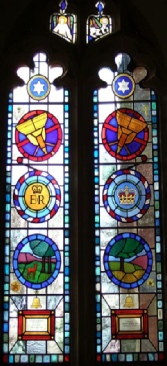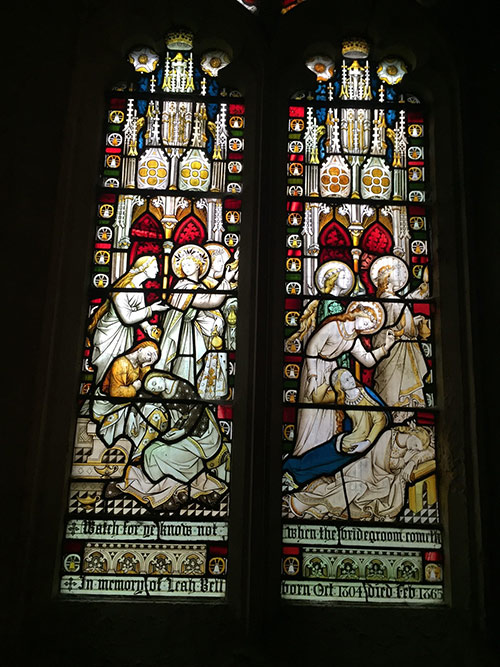Ringers' Windows
South Petherton
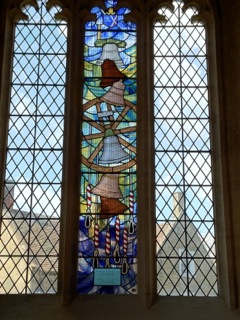
South Petherton church has a beautiful new ringers' stained glass window (on the left), which was dedicated on May 6th, 2012.
There are two windows on the West end of Petherton church, and one already had a central panel commemorating the Millennium. About a year ago, Reg Beale started working on providing a new window for the other side, in memory of his parents. He employed John Yeo from Bowlish, near Shepton Mallet, to make the window, which is dedicated to all the ringers in the parish, past and present.
The Service of Dedication was conducted by Rev Chris Marshall and Rev Mark Jackson, and was attended by a large number of local people and ringers from far and wide. Everyone agrees that this window is an excellent addition to the church, and it will be especially admired by ringers visiting the church. Thankyou Reg, for your generosity and for enabling us to have this work of art in Petherton. (Photo by Johan Smith)
Bradford on Tone
This beautiful window (on the right) has recently been installed in Bradford on Tone church.
The artist was Jane Gray of Shrawardine Shrewsbury, who worked on the new Coventry Cathedral in the 1950's.
There were delays due to sickness and the person doing the lead work in Shrewsbury but the final work was done by Owlsworth Heritage Stained Glass of Dorton, Buckinghamshire, and installed by them.
I gave this window to celebrate the Diamond Jubilee and the Bell Ringers of Bradford on Tone. I did all paperwork and covered the full cost. I was given my 40 year certificate this year as a member of the Taunton Branch.
The church is open every day if you wish to come over. David Richards. (With thanks too to the Taunton Branch Newsletter, where the picture first appeared.)
St Michael’s, East Coker
The story of the stained glass window made by David (Tony) Mitchell
In 1984 I retired early from The Wellcome Foundation where for twenty-five years I had been an analytical chemist developing instrumental methods of analysis. At this time we were living in Hartley, Kent, and my eldest daughter was training as a nurse at Yeovil District Hospital, my younger daughter was at university and my son wanted to study agriculture to study at Cannington Agricultural College, so a move to Somerset was indicated. We went to a delightful cottage in Back Street, East Coker, where we became friends with our neighbours Dorothy (Dot) and Albert (Alb) Hughes. Alb, who was an expert bell ringer, soon suggested that I learnt to ring at St. Michael's Church, East Coker. This was a new experience for me and I made all the usual mistakes but the Tower Captain, Miss Charles, assisted by Rose Parsons, were very patient with me and eventually I managed to follow the “cards” well enough for me to be allowed to ring at weddings.
One day we found the lower slit window lying broken on the floor of the Bell Tower, and whenever the wind got up it gave a cold draught that blew under the door of the ringing chamber. So a piece of 'Perspex' plastic was cut to fit the window and held in place with some temporary clips. This was not at all satisfactory as the Perspex blew out in a strong wind, so the idea came to me to make a proper stained-glass window to replace the broken one made of ordinary window glass. My only previous experience in this field was a panel that I had made in the East Coker Stained Glass Studios under the tuition of Molly Kettlewell and Sally Jackson, both of whom were gifted artists and very experienced stained-glass crafts-women.
Molly very kindly allowed me to work in her studio while I made the window and I began by sketching out possible designs; a bell rope sally seemed suitable because it was the right shape for a slit window and the bright colours would give a cheerful look to the window. A full sized cartoon was made of the window (92 x 9cm) and shown to the Vicar, the Reverend David Hunt, for his views. He was sympathetic to my wish to repair the window but said that no alteration or change to the fabric of the Church could be made without the prior approval of the Church Architects, but as restrictions on the Bell Tower were less strict I could go ahead provided I didn't damage or modify any of the stone work, and that I was prepared to remove the window if the Church Architects objected to it. I kept the broken bits of glass so that I could put them back on the floor if I had to take out the new window. So far, my stained-glass is still there after nearly eighteen years!
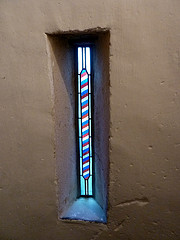 With the design completed next came planning the details of construction. Molly pointed out to me that lead came (a 'came' is the H section strip of metal that holds the glass in place) would take up an appreciable proportion of the sally and so make the window dark. One solution Molly suggested was that I encase each piece of coloured glass in a narrow copper foil came, as copper was much thinner than lead. This was a sound method, but I first wanted to try to eliminate the cames between each of the coloured sections by using sheets of red and blue flashed-glass back to back, each having a clear area to allow the other colour to show through. (Flashed-glass is white or coloured glass with a very thin layer of brightly coloured glass on one side. Sticky backed plastic film, cut to the pattern one wants, is applied to the coloured side of the flashed-glass where one wants the colour to remain, and the glass is then put in hydrofluoric acid to etch away the exposed coloured layer leaving the glass transparent.). Further problems arose: there was no acid proof dish available that was large enough to take the sally, and no flashed-glass sheets large enough to make the sally in one piece. To buy a large sheet of top quality flashed-glass and only use a part of it would be very expensive, so the decision was made to use the small pieces of glass available and make the sally in several parts for each colour, and then to join them used clear epoxy-resin cement. The cutting of the glass and the etching went well, and the rope at each end of the sally was cut from yellow glass on which was painted the texture and strands of the rope using glass- paint which was fired into the surface of the glass in the kiln.
With the design completed next came planning the details of construction. Molly pointed out to me that lead came (a 'came' is the H section strip of metal that holds the glass in place) would take up an appreciable proportion of the sally and so make the window dark. One solution Molly suggested was that I encase each piece of coloured glass in a narrow copper foil came, as copper was much thinner than lead. This was a sound method, but I first wanted to try to eliminate the cames between each of the coloured sections by using sheets of red and blue flashed-glass back to back, each having a clear area to allow the other colour to show through. (Flashed-glass is white or coloured glass with a very thin layer of brightly coloured glass on one side. Sticky backed plastic film, cut to the pattern one wants, is applied to the coloured side of the flashed-glass where one wants the colour to remain, and the glass is then put in hydrofluoric acid to etch away the exposed coloured layer leaving the glass transparent.). Further problems arose: there was no acid proof dish available that was large enough to take the sally, and no flashed-glass sheets large enough to make the sally in one piece. To buy a large sheet of top quality flashed-glass and only use a part of it would be very expensive, so the decision was made to use the small pieces of glass available and make the sally in several parts for each colour, and then to join them used clear epoxy-resin cement. The cutting of the glass and the etching went well, and the rope at each end of the sally was cut from yellow glass on which was painted the texture and strands of the rope using glass- paint which was fired into the surface of the glass in the kiln.
Then tragedy struck, Molly was injured in a car accident which left her unable to carry on with the Studios. By good fortune the bits for the sally had been completed and the remainder of the work could be finished in the workshop in my garden.
To assemble the pieces of the sally a jig was needed that would hold the pieces securely for twenty-four hours while the epoxy-resin hardened, then the edges of the sally were sealed with more epoxy-resin applied thickly enough to give support to the glass. Lead cames were fitted around the outside of the sally and the joints soldered. The cartoon was put on a wooden surface and the sally position centrally, lead cames were put round the outline of the window and held in place with nails hammered into the wood (traditionally horseshoe nails are used, but I had to make do with ovals.) Next, small pieces pale coloured glass were cut to make the border surrounding the sally and these were put in cames and all the joints soldered. Black putty was rubbed into gaps between the glass and the cames to make it weather proof. The window was now ready to be fixed in the window slit of the Bell Tower. The outer edge of the came was bent inwards to match the 'V' shape of the arrow-slit and the window offered up to the stone work and the edge of the came adjusted to give a snug fit. The stained-glass was held in position by two slithers of lead fixed to the stone on either side with a little epoxy-resin. This sufficed to hold the window in place until it was sealed with silicone put in the outer edge of the came. When all was set, the inner edge of the came was gently bent to touch the stonework, thus hiding the sealant.
Lime mortar is the traditional material used in stonework, as cement is too hard and has no 'give' in it. I made a range of coloured mortars and compared them with the stonework; it took about a dozen attempts to obtain a good match. On Tuesday, 11th of March 1997 the outside of the window was sealed in place with lime mortar and the window was now complete.
© David Mitchell 2015.
Halstock, Dorset
A new window has been installed at St Juthware and St Mary's, Halstock, to commemorate the contribution made to the church and the village by the Marwood family, who were farmers in the village from 1935 to 2006.
Brian Marwood was a Churchwarden, a member of the PCC, a member of the choir and Captain of the Ringers. The window was paid for by the Marwood family, as a memorial. It was designed by Sally Pollizer from Shelpton Mallet.
The Theology Behind the Design, by Rev' David Harknett, 2012.
Jeremiah Gumm, a Lutheran Pastor serving in the United States, paraphrases the Augsburg Confession (Article XXIV); "all symbolism in worship should serve the purpose of teaching the people what they need to know about Christ". Thus stained glass in churches has traditionally depicted biblical accounts or teachings, the familiar stories of God's Word and his precious truths.
This 'sign language of the faith' or "The Visual Word" is not the primary symbolism of the proposed design. Yet it is overt in the quartrefoil light consisting of a chalice which captures the worshippers' communion with God as they return to their seats from the Fellowship table.
The two-light window complements this centre-piece of Christ's story (his blood shed for sinners) by depicting the story of a valued member of the church body, namely Bryan Marwood. And not only Mr Marwood's story, but also that of his mother and aunt. Their involvement in the past life of St.Mary's takes in organ-playing; choir-singing; bell-ringing and in Mr Marwood's case, church-wardening. And as Captain of the Bell-Ringers, it is entirely appropriate that the chosen window is located in the Bell Tower.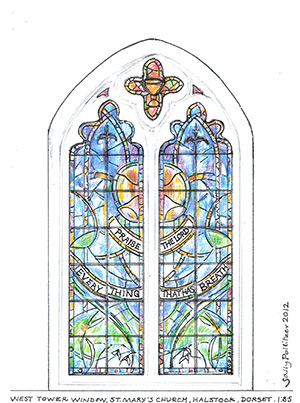
Sally Pollitzer's design of glowing light and colours expresses the life & dynamism inherent to the Christian faith. There is the suggestion of bell-ropes rising & falling, with bells alluded to in abstract and echoed in the flora. Bells in the bible don't feature in our contemporary sense, though the ancient cymbals mentioned in Psalm 150:5-6 may be precursors.
"Praise him with the clash of cymbals, praise him with resounding cymbals.
Let everything that has breath praise the LORD."
These cymbals are said to have resembled water pitchers with wide-open necks, similar to the bells of today. And through the centuries, church bells have acted as a call to worship, a reminder that God's good news continues to be played out in our lives.
"I heard the bells on Christmas Day / Their old familiar carols play,
And wild and sweet the words repeat / of peace on earth, good will to men." (Longfellow)
It is possible to see an abstract chalice in the shape emanating from the base of the two-light window, or perhaps cupped hands suggestive of the Eucharistic Feast. There again, this shape may call to mind a growing tree, which with the flora speaks of God's wonderful creation, be that in the context of the Genesis story or the context of St.Mary's, situated as it is in beautiful countryside. The glowing light emanating from the central area can be interpreted in a range of ways, from the sun making its circuit of the heavens (Psalm 19) through to the transfigured face of Jesus, which shone like the sun (Matthew 17).
The abstract design of the Tower window will act as a beautiful partner to the Table window opposite. In that plain design, key figures in Jesus' story are depicted :- St.Peter; St.Mary; St.Mary Magdalene; St.John. They stand in a row beneath Christ on the cross, who is accompanied by 3 angels proclaiming, 'Alleluia' – Hebrew for 'praise the Lord' (hallel-lu-jah : see Psalm 150 above).
St.Mary's is very much a living church, seeking to (in the words of the Psalmist), “pass along to the next generation God's fame and fortune, the marvellous things he has done”. God's story continues to be lived out & played out in St.Mary's, and most importantly through the current worshippers, God's 'living stones'. So I find it very fitting that the building, our 'sacred space' is to be graced by such an uplifting piece of art and I propose that a biblical inscription be added as noted above; “Let everything that has breath praise the Lord” (Psalm 150).
Silton, near Wincanton.
This is an amazing church. The walls are covered from head to toe in wallpaintings, and there is a massive delicately carved alabaster monument. The window in the South Aisle is by John Richard Clayton (1827–1913) and Alfred Bell (1832–95). It's not really a ringers' window, but it's got such lovely bells on it that it seems appropriate to include it here. It's a memorial to Leah Bell (nee Suter) who was born in 1804, and died in 1865. Down each side of the window are tiny bells, each with a wheel. (Photo by David Hammonds). To add to the pleasure of a visit to Silton, there is a 1,000 year old oak tree in the field beyond the churchyard wall!

